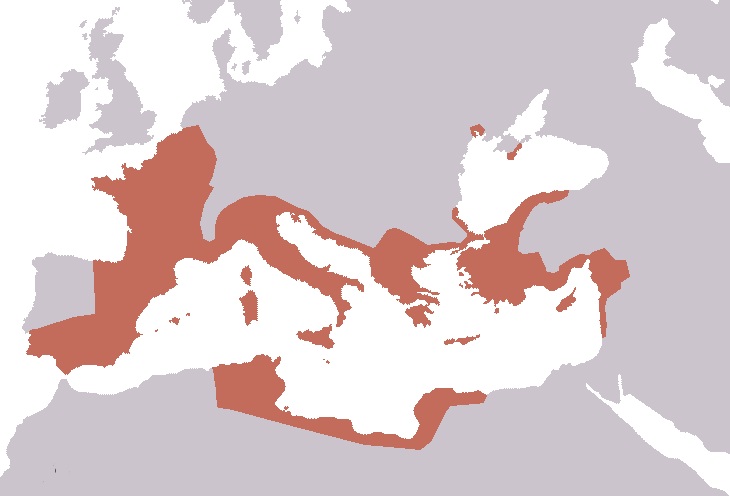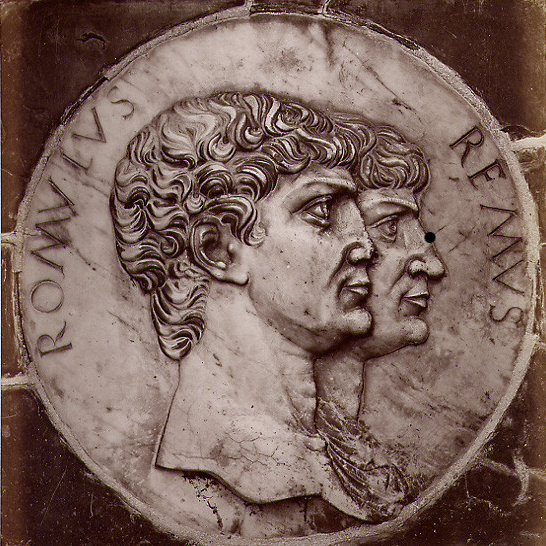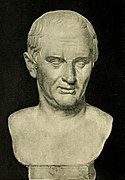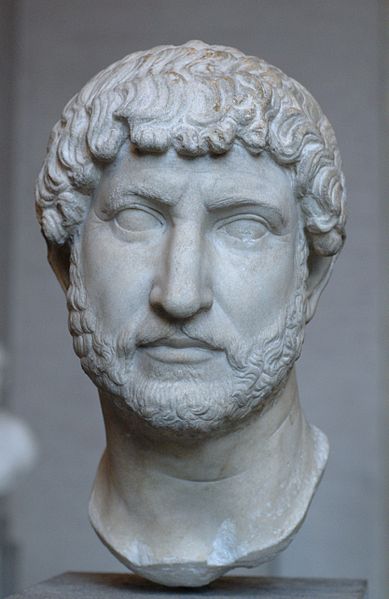
Map of the Roman Republic in 40 BCE
Topics on the Page
The Roman Republic
Notable Figures
A. Romulus and Remus
- Founding of Rome: Facts and Myths
B. Hannibal and the Carthaginian Wars
C. Marcus Tullius Cicero
D. Julius Caesar
E. Augustus
F. Trajan
G. Hadrian
H. Women in Roman History
Focus Question: Who are the mythical and historical figures that were significant in the rise of the Roman Republic?
The Roman Republic
 The timeline of the Roman Empire can be divided into three eras:
The timeline of the Roman Empire can be divided into three eras:
Click here for a Khan Academy overview titled "The Rise of Rome"
Click here for a timeline of the Roman Republic's leaders!
Click here to watch "The Rise of the Roman Republic"
Click here for background on the Roman Republic from the Metropolitan Museum of Modern Art.
Roman Republic from BrainPop
Elections in the Late Roman Republic: How Did They Work? BBC History
Click here to learn about what life was like in Ancient Rome!
Click here to learn about the Rome's transition from Republic to Empire!
Click here for Roman Republic teaching tools!
Check out these pages to learn more about Roman Gods and Goddesses!
1. Video about Roman Gods and Goddesses
2. National Geographic articles on Roman Gods and Goddesses
3. Roman Gods and Goddesses for Kids
Notable Figures

According to the Roman mythology, the founders of Rome were Romulus and Remus.
Romulus and Remus were twin sons of the god Mars and priestess Rhea Silvia, the daughter of King Numitor of Alba Longa.
- Rhea Sivia was a Vestal Virgin. This is significant because Vestal Virgins had to watch the sacred fires of Rome. If the fire blew out, the Vestal Virgin was buried alive.
- Even in present day, there are still sacred fires. One is at the Arc of Triumph in Paris, where the unknown soldier (French) is buried. There is also the eternal flame in Arlington Cemetery.
To learn more about Vestal Virgins, check out this video by Ted Ed.
Numitor's brother, Amulius, deposed Numitor from rule and, to be sure that Romulus and Remus would not be able to dethrone him later in life, Numitor threw the twins into the River Tiber in a trough. The river was flooding at this time, but the twins made it ashore safely. A she-wolf found the twins and they drank her milk until a shepherd named Fastulous found them and raised them as his own with his wife.
In adulthood, Romulus and Remus put their grandfather, Numitor, back in power of Alba Longa by killing Amulius. The twins decided to build a city of their own at the location where they had been nursed by the she-wolf. Romulus killed Remus for criticizing the walls being built on the Palatine Hill, but continued to build the city, naming it Roma (Rome) in honor of his own name.
- Romulus went on to establish the Roman Senate.
For more information on Romulus and Remus, click here.
Check out this video for more on the founding of Rome.
 Click here and here for kid-friendly sources on Romulus and Remus!
Click here and here for kid-friendly sources on Romulus and Remus!
Woodcut of Rhea Silvia and the birth of Romulus and Remus, 1474

See this article on Rhea Silvia to learn more about the mythical mother of Romulus and Remus.
Archaeologists unearth Lupercale. According to legend, the she-wolf nursed Romulus and Remus.
B. Hannibal and the Carthaginian Wars
Hannibal Barca was the famous General of Carthage who crossed the Alps with his elephants to fight the Romans about 2,200 years ago. Carthage - with its capital near Tunis in modern-day Tunisia, North Africa - was a trading empire that had co-existed with Rome for many centuries. Eventually the two empires clashed in the series of three wars called the Punic Wars.
 |
| Carthaginian Empire at 264 BC, prior to the Punic Wars. |
In the Punic Wars, Rome defeated Carthage three times, finally destroying the city and the empire.
- Hannibal Barca took part in the Second Punic War (218-202 BC). He attacked Saguntum in Spain then invaded Italy; he rampaged through Italy for 16 years, inflicting horrific defeats on the Roman forces.
- He was never defeated in a major engagement by the Romans in Italy but was gradually bottled up in the south of the country. Rome invaded his north African homeland, and he was called to defend it, and at Zama he suffered his first major defeat that ended the Second Punic War.
- Hannibal was then on the run and traveled through the Middle East, selling his military skills, usually to the opponents of Rome's allies. Finally, Hannibal was trapped (in present-day Turkey) and poisoned himself to avoid capture.
After Rome was victorious in the Second Punic War, Carthage was content to end the fighting.
However, war-hungry Roman Senators repeatedly called for the destruction of Carthage, leading to a three year, Third Punic War. The conclusion of the Third Punic War saw Roman victory, and the Romans burned Carthage to the ground. The most important battle in the Third Punic War was the Battle of Carthage, also known as the Siege of Carthage, in which the Romans sacked and took the city, ending the Carthaginian Empire.
To view the battle sites of the Second Punic War, check out this interactive map.
 Video Resources
Video Resources
- Edu-tainment at its finest. Long but excellent movie; introductory sequence can be used as a good hook for a unit on Hannibal: Hannibal: Rome's Worst Nightmare.
- Part Seven of the documentary, A Great and Mighty Walk, in which Doctor John Henrik Clarke discusses the significance of Hannibal.
Click here for background on the Third Punic War.
 |
| Hannibal's and Asdrubal's routes and the Roman's offensives |
C. Marcus Tullius Cicero

Marcus Tullius Cicero was born on January 3, 106 BC and was murdered on December 7, 43 BC. He was, among other things, an orator, lawyer, politician, and philosopher.
He placed politics above philosophical study; he believed the latter was valuable in its own right but was even more valuable as the means to more effective political action. The only periods of his life in which he wrote philosophical works were the times he was forcibly prevented from taking part in politics.
His life coincided with the decline and fall of the Roman Republic, and he was an important actor in many of the significant political events of his time.
 Click here for selections from Cicero's writing and speeches.
Click here for selections from Cicero's writing and speeches.
For deeper reading on Cicero, check out this book by Anthony Everitt.
For an interactive lesson on understanding the organization and concerns of Roman leadership, click here.
Click here for a video about Cicero and the Roman Republic.
Click here for "5 Reasons We Should Still Read Cicero"!
D. Gaius Julius Caesar
Influential Literature Page: Julius Caesar by Shakespeare

Julius Caesar was born July 12 or 13, 100 BC into a politically well-connected family.
- After several government postings, such as governor of Spain and governor of Roman Gaul (where he added the entirety of modern-day France and Belgium to the Roman Empire and made two trips to Britain), Caesar went back to Italy.
-
- After he returned, he began an uprising against Rome's republican forces, whose leader and former ally of Caesar, Pompey, fled to Egypt. Upon Pompey's departure, Caesar controlled Rome and ruled as consul and dictator until his assassination.
Caesar ruled as Rome's first solo leader, and used his power to enact reforms such as lessening the debt and increasing the size of the Senate.
 |
| The Death of Julius Caesar by Vincenzo Camuccini (1804-1805) |
- Through his actions, Caesar alienated himself from republican senators, and was assassinated by republican senators, Cassius and Brutus on March 15, 44 BC (now the Ides of March). Caesar's death brought about civil wars that ended the Republic and introduced Octavian, Caesar's nephew, as Rome's first emperor.
Mark's Antony Funeral Oration is included in Act 3 Scene 2 from William Shakespeare's play, The Life and Death of Julius Caesar (1599).
Click here for The Gallic Wars by Julius Ceasar.
Click here for a timeline and historical background of Ceasar's life from Barbara McManus of The College of New Rochelle.
Watch this video clip to find out more information on Caesar's Assassination. Did Caesar have time to utter his famous last words?
Ted Ed's The Great Conspiracy Against Julius Caesar
- Dive deep with Robert Garland's Julius Caesar, covering the moments leading up to his death.

Map of Caesar's conquests in red. Arrows show flight of senate after Caesar returns to Rome.
E. Augustus

After the assassination of Julius Caesar, the Roman world was divided between Caesar's heir, Octavian, and his assistant, Antony. At the Battle of Actium in 31 BCE Octavian was able to prove his superiority and defeated the combined forces of Antony and his lover, the Egyptian pharaoh Cleopatra, thus ending the Republic. Octavian became the first Roman emperor under the title of Augustus and vowed to restore the Republic. Augustus' power went hand in hand with his control of the armed forces.
Augustus' Republic allowed senators to appoint governors to provinces and allowed the emperor to control certain provinces. He had successfully created and implemented a new regime based on imperial policies that kept the traditional values intact.
Augustus also played a major role in expanding the Roman trade network by establishing a place for the empire along the Silk Road, which traveled through large parts of Europe and Asia. He ruled for 45 years and is known as the first ruler of the Julio-Claudian dynasty.
Watch this video clip to find out more information on Emperor Augustus's Palace.
Click here for a video about the life of Augustus.
Click here to play a game where YOU can be a Roman Emperor!
Click here for a timeline of Roman Emperors after the fall of the Republic!
Click here to watch "History vs. Augustus"!
F. Trajan
 |
| The Roman Empire at the end of Trajan's time as emperor |

Marcus Ulpius Traianus, also known as Trajan, became Roman Emperor in 98 AD until 117 AD.
Trajan was the first emperor born outside of Italy. He is best known for his building projects throughout Rome and his military campaigns against the Dacians and Parthia, extending the Roman Empire to its fullest extent.
The Dacians inhabited Eastern Europe, around modern-day Romania.
Trajan's Column depicts the Dacian campaign, emphasizing his power and his ruler-ship. Parthia was located in modern day Iran. Both were conquered by Trajan in his time as Emperor. Due to his great expansion of the Roman Empire, Trajan made the Empire a multi-cultural melting pot. According to Edward Gibbons, an eighteenth-century historian, he was one of the Five Good Emperors of the Roman Empire.
To learn more about Trajan's Empire, watch this video, Engineering an Empire: Trajan.
A War Diary Soars Over Rome from National Geographic.
G. Hadrian

Hadrian (AD 76-138) was a Roman emperor in the Julio-Claudian dynasty (117-138) who declared an end to the expansion and over-extension of the empire and drew it back to the limits established by Augustus. He served with distinction in military campaigns with emperor Trajan on the Danube frontier and became consul several times. When Trajan died in 117,
Hadrian was proclaimed emperor by the army and his appointment was then ratified by the Roman Senate.
- Hadrian strengthened his position by liberalism toward the people, by support of poor children, and by a considerate attitude toward the Senate.
- In several extended tours he visited nearly every Roman province, setting local political, military, and economic affairs in order and strengthening loyalty to Rome. His favorite, Antinoüs, traveled with him; when the youth drowned, Hadrian deified him.
- In 134-35 the emperor revisited Judea, where he put down a lengthy insurrection of the Jews at a reported cost to them of half a million lives.
- Hadrian spent the closing years of his life partly in Rome and partly at his palatial villa at Tibur (modern Tivoli). He died at Baiae (modern Baia) on July 10, 138, and was succeeded as emperor by Antoninus Pius.
- One of the most cultured of the emperors, he was a patron of virtually all the arts. A highly cultivated man, Hadrian surrounded himself with poets, philosophers, and scholars. He wrote verse and prose in Latin and Greek with notable skill.
- In Rome his passion for architecture could be seen by the erection of such magnificent buildings as the Athenaeum (an academy for the promotion of learning), the Temple of Venus and Roma, the Pantheon (rebuilt), his massive mausoleum (Castel Sant'Angelo), and, in Athens, many other buildings.
Click here to watch "The Ancient Roman Emperor Hadrian"!
Who Are You? Take a Quiz to find out which Roman Emperor you are!
Hadrian's Wall
 |
| Section of Hadrian's Wall |

He established a series of defense fortifications, including the famous Hadrian's Wall, that historically marked the end of Roman territorial expansion.
The Roman Empire at the time was repeatedly threatened by revolts of subject peoples and by barbarian invasions.
Recognizing the need for consolidation, Hadrian resolved to abandon the outlying provinces.
Overview of the purpose and origin of Hadrians_Wall.
 Click here to watch "What Is Hadrian's Wall?"
Click here to watch "What Is Hadrian's Wall?"
 Women in Roman History
Women in Roman History
The Role of Women in Roman Elegy: Counter-Cultural Feminism from JSTOR.
Roman Women: Following the Clues from the BBC.
A Compilation of Important Women from Roman History from UPenn.
 Podcast on Life in Ancient Rome through the Eyes of a Young Girl.
Podcast on Life in Ancient Rome through the Eyes of a Young Girl.
 Four Sisters in Ancient Rome by Ted-Ed.
Four Sisters in Ancient Rome by Ted-Ed.
Sources
http://www.unrv.com/culture/romulus-and-remus.php
http://www.iep.utm.edu/c/cicero.htm
http://languages.lakeheadu.ca/uploads/newsletter/Newsletter-Vol-7/V7HP02.JPG
http://www.fact-index.com/r/rh/rhea_silvia.html
http://www.pbs.org/empires/romans/empire/cleopatra.html
https://www.sedl.org/loteced/scenarios/latin_multicultural.html
http://www.vox.com/2014/8/19/5942585/40-maps-that-explain-the-roman-empire
William J. Duiker and Jackson J. Spielvogel, World History, Vol. 6 (Boston: Wadsworth).






Click here to watch "What Is Hadrian's Wall?"
Women in Roman History
Podcast on Life in Ancient Rome through the Eyes of a Young Girl.
Four Sisters in Ancient Rome by Ted-Ed.
Comments (0)
You don't have permission to comment on this page.